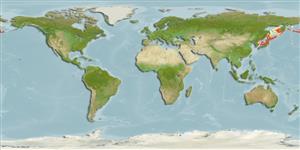sub class Elasmobranchii (ฉลามและกระเบน) (sharks and rays) >
Rajiformes (Skates and rays) >
Arhynchobatidae (Softnose skates)
Etymology: Bathyraja: Greek, bathys = deep + Latin, raja, -ae = a ray (Raja sp) (Ref. 45335); smirnovi: Named for 'Mr. Smirnov', Inspector of Fishes, who collected fishes from the Sea of Okhotsk (Ref. 89865).
Environment: milieu / climate zone / depth range / distribution range
นิเวศวิทยา
เกี่ยวกับทะเล,น้ำเค็ม สัตว์น้ำหน้าดิน; ระดับความลึก 100 - 1000 m. Temperate; - 36°N (Ref. 89865)
North Pacific: Sea of Okhotsk, Kuril Islands, and the Sea of Japan.
ขนาด / น้ำหนัก / Age
Maturity: Lm ? range ? - ? cm
Max length : 102 cm TL เพศผู้/กระเทย; (Ref. 89865)
Short description
สัณฐานวิทยา | ความยาวต่างๆ
This species is distinguished by the following characters: no blotches on the dorsal disc surface or a pair of white or dark blotches; dark blotch and band usually absent on the ventral disc surface; predorsal caudal vertebrae 80-87 (Ref. 123274)..
Geographical variations are present in the populations of the seas of Japan and Okhotsk: number of total tail thorns, ranging from 21-33 (average and standard deviation: 27.3±2.9) (southern Sea of Japan) vs.19-29 (26.0 ± 2.3) (northern Sea of Japan), vs. 22-27 (24.3 ± 1.5) (Sea of Okhotsk) (P < 0.05) and the frequency distribution of tail thorn numbers was bimodal in the Sea of Japan [modes: 25 and 28,29 (southern); 25,26 and 28 (northern)], but unimodal in the Sea of Okhotsk (mode: 25) (Ref. 123274).
Oviparous. Distinct pairing with embrace. Young may tend to follow large objects, such as their mother (Ref. 205). Eggs are oblong capsules with stiff pointed horns at the corners deposited in sandy or muddy flats (Ref. 205). Egg capsules are 12.4-15.0 cm long and 8.7-9.0 cm wide (Ref. 41249, 41253). Depth range given by H. Ishihara (pers.comm. 07/07). Reported to feed primarily on amphipods, decapods, fishes, euphausids, and squid on Yamato Bank in the Sea of Japan. Maximum length reported 116 cm TL (Ref, 89865).
Life cycle and mating behavior
วัยเจริญพันธุ์ | การสืบพันธุ์ | การวางไข่ | เซลสืบพันธ์ของเพศเมีย(ไข่) | ความดกของไข่ | ตัวอ่อน
Oviparous, paired eggs are laid. Embryos feed solely on yolk (Ref. 50449). Distinct pairing with embrace. Young may tend to follow large objects, such as their mother (Ref. 205). Eggs have horn-like projections on the shell (Ref. 205).
Misawa, R., A.M. Orlov, S.Y. Orlova, I.I. Gordeev, H. Ishihara, T. Hamatsu, Y. Ueda, K. Fujiwara, H. Endo and Y. Kai, 2020. Bathyraja (Arctoraja) sexoculata sp. nov., a new softnose skate (Rajiformes: Arhynchobatidae) from Simushir Island, Kuril Islands (western North Pacific), with special reference to geographic variations in Bathyraja (Arctoraja) smirnovi. Zootaxa 4861(4):515-543. (Ref. 123274)
IUCN Red List Status (Ref. 130435)
Threat to humans
Harmless
Human uses
ข้อมูลเพิ่มเติม
Age/SizeการเจริญเติบโตLength-weightLength-lengthLength-frequenciesความยาวต่างๆสัณฐานวิทยาตัวอ่อนพลวัตของสัตว์น้ำวัยอ่อนการทดแทนที่อุดมสมบรูณ์BRUVS
อ้างอิงการเพาะเลี้ยงสัตว์น้ำประวัติการเพาะเลี้ยงสัตว์น้ำสายพันธุ์พันธุศาสตร์ElectrophoresesอัตราพันธุกรรมโรคการแปรรูปNutrientsMass conversion
ผู้ร่วมมือรูปภาพหลายรูปStamps, Coins Misc.เสียงปลามีพิษ เช่น ปลาปักเป้าความเร็วรูปแบบการว่ายน้ำพื้นที่เหงือกOtolithsสมองวิสัยทัศน์
เครื่องมือ
Special reports
Download XML
แหล่งที่มาจากอินเตอร์เน็ต
Estimates based on models
Preferred temperature (Ref.
123201): 0.6 - 3.8, mean 1.6 °C (based on 122 cells).
Phylogenetic diversity index (Ref.
82804): PD
50 = 0.5000 [Uniqueness, from 0.5 = low to 2.0 = high].
Bayesian length-weight: a=0.00513 (0.00253 - 0.01042), b=3.12 (2.95 - 3.29), in cm total length, based on LWR estimates for this Genus-body shape (Ref.
93245).
ระดับชั้นอาหาร (Ref.
69278): 4.0 ±0.7 se; based on size and trophs of closest relatives
ความสามารถในการกลับคืนสู่ปกติ (Ref.
120179): ต่ำ, เวลาต่ำสุดที่จะทำให้ประชากรเพิ่มขึ้นเป็น 2 เท่าใช้เวลา 4.5 - 14 ปี (Fec assumed to be <100).
Fishing Vulnerability (Ref.
59153): High vulnerability (61 of 100).
